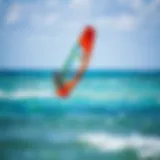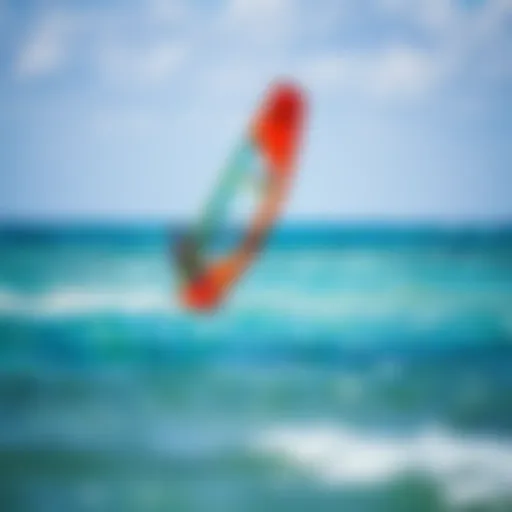In-Depth Guide to Real Kite Surfing Techniques and Destinations
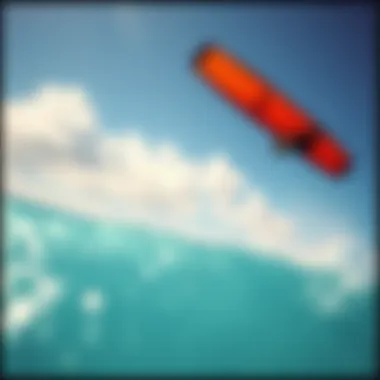
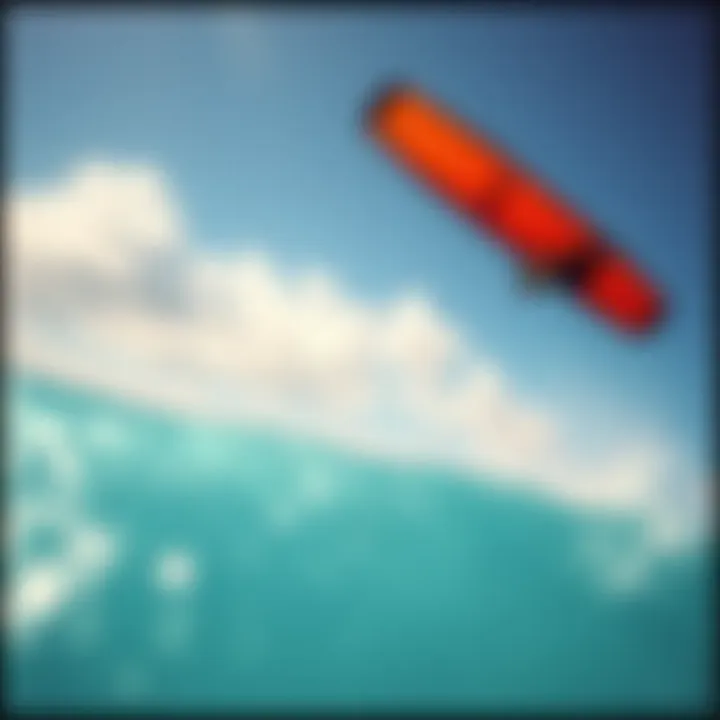
Intro
Kite surfing, often labeled as one of the most exhilarating water sports, combines the thrill of surfing with the finesse of flying a kite. For those looking to immerse themselves in this dynamic activity, understanding its core techniques and equipment is vital. Whether you are a novice peeking into the world of kiteboarding or an experienced surfer striving to enhance your skills, this guide will serve as your roadmap through the waves.
As we navigate the vast ocean of kite surfing, we will delve into essential techniques that cater to all levels. After all, mastering kite surfing doesn't happen overnight; it unfolds through practice, patience, and a willingness to learn. We'll also explore the various types of gear, dissecting what makes each piece of equipment ideal for different conditions and skill sets. So, hang tight and get ready to glide over the waves with newfound knowledge!
Techniques for Kiteboarding Enthusiasts
The heart of any water sport lies in its techniques; kite surfing is no different. From mastering the basics to executing complex maneuvers, there's a wealth of skills waiting to be learned. Let’s break it down.
Beginner Techniques
For those just starting out, a solid foundation is critical. Here are a few techniques to focus on:
- Understanding Wind Direction: Grasping the wind's behavior is key. Good kite surfers must feel the wind and know its strength and direction. Practice flying your kite on land to develop sensitivity.
- Launching and Landing: These two skills are essential. Learning to communicate effectively with your partner can reduce stress—it's all about timing.
- Body Dragging: This technique aids in getting comfortable in the water. Dragging your body in the water helps you understand how the board will feel later on.
- Riding Basics: Once comfortable with body dragging, it's time to get on the board. Begin with small rides and gradually build your confidence.
Advanced Maneuvers
For those with a bit more experience under their belt, diving into advanced maneuvers can elevate your kite surfing game:
- Jumping: This involves generating lift from the kite while keeping an eye on your landing spot. Always practice in a safe, controlled environment.
- Kiteloops: A thrilling move that requires precision; pulling hard on the back lines can send you into a loop, giving you a rush like no other.
- Transitions: Switching directions smoothly can help improve your overall flow and style. Work on your transitions to keep your moves sharp.
"The key to joy in kite surfing is knowing when to push boundaries while respecting the water and wind."
These techniques embody the spirit of kite surfing; developing them can transform your approach to the sport.
Equipment Reviews
Gear selection plays a pivotal role in the kite surfing experience. Not all kits are made equal, and understanding what works best for your style is instrumental.
Kite Reviews
Selecting the right kite is like finding the perfect partner in dance. Consider these popular brands:
- Naish: Known for stability and versatility, perfect for varying conditions.
- Slingshot: Offers innovative designs and unmatched performance.
- Liquid Force: Favors a balance of power and control, ideal for beginners and pros alike.
Board Reviews
The board is your connection between you and the water. Here are a few noteworthy types:
- Directional Boards: Great for enthusiasts who enjoy wave riding; they allow for more control.
- Twin-Tip Boards: The most common choice, suitable for various skills, providing ease in learning tricks.
- Foil Boards: These boards elevate you above the water, offering a completely new experience of riding.
For in-depth insights and specifications, sites like Wikipedia or Reddit frequently gather reviews and user experiences which can help tailor your choices.
Whether standing atop the board or simply enjoying the thrill of gliding through the waves, each moment encourages growth within this dynamic sport.
Understanding Kite Surfing
Kite surfing, often dubbed as one of the most exhilarating water sports, requires a solid understanding of various elements to truly appreciate the activity. By examining its intricacies, enthusiasts can unlock the full potential of this thrilling experience. Not only does it enhance the enjoyment of the sport, but it also promotes a safer approach, especially for those just starting out.
Understanding kite surfing entails diving into its unique mechanics, the interplay between wind, water, and the rider, along with the distinct culture that surrounds it. Knowing the foundational principles can vastly improve an individual’s proficiency and confidence in navigating the waters, and it helps foster a connection with fellow kite surfers, drawing them into a vibrant community of enthusiasts.
The importance of kite surfing also lies in its emphasis on skill development. A well-rounded comprehension of the sport leads surfers to make informed decisions regarding equipment selection, technique refinement, and safety protocols. Gaining insights into kite surfing not only positions individuals for greater success in their personal pursuits but also enriches the overall legacy of the sport. By immersing oneself into these aspects, individuals may find themselves hooked, continually striving for the next big wave or trick.
"Kite surfing is not merely a sport; it's a journey into the harmony of water and wind, demanding respect and understanding."
The Evolution of Kite Surfing


Kite surfing hasn't been around forever; it has evolved significantly since its inception. Originally rooted in the simple idea of harnessing wind power, kite surfing began in the 1970s when pioneers like Gijsbertus Adrianus Panhuise started experimenting with using kites as sails for watercraft. From those humble beginnings, the sport embarked on a journey, absorbing influences from various cultures and innovating techniques along the way.
By the 1980s and 1990s, the sport began to take shape as we know it today. The introduction of inflatable kites drastically changed how kite surfing was approached. These new designs provided greater control, improved safety, and increased performance. As a result, kite surfing gained traction worldwide, attracting thrill seekers and beach lovers alike.
Modern kite surfing has seen substantial advancements in technology. Kites are now designed to be more reliable, responsive, and resilient. Advanced materials and rigging systems have further propelled the sport, allowing surfers to perform spectacular tricks while maintaining a firm grip on safety.
Distinguishing Kite Surfing From Other Water Sports
Kite surfing, while sharing the water with other sports, stands out for several reasons. First and foremost, the integration of kites into the surfing experience creates a unique dynamic, where the surfer is not just steering a board but also maneuvering an airborne sail. This duality enhances the thrill, as capabilities can change dramatically with differing wind conditions.
When compared to windsurfing, kite surfing offers surfers the ability to ride the waves more freely. In traditional windsurfing, the rig is physically attached to the board, which limits mobility. Kite surfers, on the other hand, can jump, twist and turn in mid-air, all while being pulled by the kite—an exhilarating feature that attracts many.
Moreover, the accessibility of kite surfing sets it apart. Many beginners can achieve success relatively quickly, thanks in part to advances in instructional techniques and equipment.
In summary, understanding the evolution and distinctions of kite surfing not only grounds enthusiasts in the sport’s rich history but also equips them with the knowledge to appreciate their journey from beginner to adept rider.
Essential Equipment for Kite Surfing
When it comes to kite surfing, having the right equipment isn’t just a minor detail; it’s essential for both safety and performance. Kite surfing relies heavily on the interaction between the rider and the wind, making the choice of gear critical. Using equipment that suits your skill level, style, and the conditions you are riding in can greatly enhance your experience and effectiveness on the water. This section will break down the core components - kites, boards, and harnesses - and how each piece contributes to both convenience and efficiency.
Kites: Types and Specifications
Kites can often be the heart of a kite surfer’s setup, and they come in various types and configurations. Understanding your kites involves knowing their designs and how they respond to wind conditions. Generally, you'll encounter three main types of kites:
- C-Kites: Known for their precision and power, they're popular among advanced riders who enjoy performing tricks. Their design gives better upwind performance but requires skill to handle.
- Bow Kites: These kites offer a wider wind range and are more forgiving for newbies. They have a flatter shape and can generate more lift, which is great for those just starting.
- Delta Kites: A good all-rounder, delta kites combine some advantages of both the C and Bow designs. They are stable and perform well in varied wind conditions.
Among the specifications to keep in mind, the size of the kite plays a vital role. Larger kites catch more wind but require more strength to control, while smaller kites offer increased maneuverability.
"Choosing the right kite isn’t about what looks good or is trendy; it’s about finding gear that complements your riding style and wind conditions."
Boards: Materials and Designs
The board is your connection to the water, making it a pivotal piece of your gear. Kite surfboards are generally made from different materials that affect performance: wood, foam, or composite materials. Each offers unique characteristics.
- Twin-Tip Boards: These are the most common for beginners. With a symmetrical shape, they allow riders to ride both ways, making them easy to learn on.
- Directional Boards: Unlike the twin-tip, directional boards are designed to ride in one direction. They are commonly used for wave riding and provide unique control.
- Foil Boards: These boards incorporate a hydrofoil that allows surfers to lift above the water, providing a unique and exhilarating experience. However, they demand a higher skill set.
When considering the design, factors like rocker and flex impact how the board interacts with the water. A higher rocker helps in choppy conditions by reducing the surface area in contact with the waves.
Harnesses and Accessories
Finally, a harness is what keeps you connected to your kite. There are two primary types:
- Waist Harness: This type is typically preferred by experienced riders, as it offers more freedom of movement and is less bulky than a seat harness.
- Seat Harness: This is more common among beginners, providing better support and comfort while minimizing fatigue, especially in the early learning stages.
In addition to the harness, various accessories enhance the kite surfing experience, such as:
- Safety Leashes: This crucial accessory detaches the kite from the rider in case of an emergency.
- Quick-release Systems: These mechanisms allow for quick disconnection from your kite if needed, adding another layer of safety.
- Footstraps and Bindings: These are essential to keep your feet securely on the board for optimal control.
In summary, your kite surfing equipment is more than just stuff; it’s your ticket to harnessing the wind and riding the waves. Choosing the right gear tailored to your needs and abilities makes a world of difference in your overall kite surfing journey.
Techniques for Real Kite Surfing
When it comes to kite surfing, mastering the techniques is crucial. These skills determine not only the enjoyment you get from the sport but also your safety on the water. Techniques range from fundamental skills needed for beginners to advanced maneuvers that unleash the full potential of kite surfing. Knowing the ins and outs of these techniques can enhance performance, build confidence, and ensure a long-lasting passion for this exhilarating sport.
Fundamental Skills for Beginners
For those just starting out in kite surfing, the importance of foundational skills cannot be overstated. It’s like learning to walk before you can run. Getting a grip on basics sets the stage for progression. Here are some fundamental skills to focus on:
- Body Dragging: This involves using the kite’s power to pull you through the water. It's crucial for getting a feel for how the kite interacts with the elements. Beginners should practice this skill in a controlled environment, away from obstacles and other surfers.
- Kite Control: Being able to control your kite is essential. You need to learn how to steer, how to make it fly higher or lower, and understand its power zones. Practice moving the kite in the air without the board first, until it becomes second nature.
- Water Starts: Once comfortable with body dragging, the next step is learning to get up on the board. The mechanics of timing your kite and board positioning can be tricky but are essential for a successful water start.
- Basic Riding: Once you’ve mastered water starts, the thrill of riding begins! Keep your knees bent and weight centered over the board for balance.


These skills form the building blocks that every kite surfer should master. They'll come in handy as one delves into more complex maneuvers in the future.
Advanced Maneuvers and Tricks
For the more seasoned kite surfers, advanced moves can add flair and excitement to the experience. These maneuvers require more skill, practice, and a good understanding of both kite dynamics and board control. Here are a few to explore:
- Jumping: This is a signature move in kite surfing. Timing your kite pull with your board's lift is crucial for achieving clean air. Practice the techniques on flat water before attempting jumps in choppy conditions.
- Backrolls and Frontrolls: These aerial flips require balance and timing. Start by practicing on land or with an instructor to understand the motion before attempting on the water.
- Looping: Kite loops can generate incredible speed and height. However, it's important to know when and how to execute a loop to avoid mishaps. Begin with small loops, gradually increasing intensity as you gain confidence.
- Transition Turns: These moves involve changing direction while maintaining speed and control. Smooth transitions can significantly enhance your riding style.
As you progress, remember that with each trick, precise kite control is key. Training with a partner or an instructor can provide invaluable tips to refine your technique.
Safety Protocols and Best Practices
Safety is paramount in any water sport, and kite surfing is no exception. Ensuring that you follow safety protocols can protect both yourself and those around you. Here are some considerations:
- Use Safety Equipment: Always wear a personal flotation device. A helmet and impact vest can offer protection during falls. Additionally, using a leash helps to keep the kite connected to you at all times.
- Pre-Flight checks: Before taking off, always visually inspect your gear for any signs of wear or damage. This can prevent accidents caused by equipment failure.
- Know Your Environment: Be aware of local wind conditions, currents, and any obstacles in the area. Knowledge of your surroundings can prevent accidents and ensure a pleasant experience.
- Practice Self-Rescue Techniques: In case of emergencies, knowing how to self-rescue can be life-saving. Familiarize yourself with the techniques to manage equipment and get back to safety.
"The sea is a wild thing; respect is the key to enjoying your kite surfing experience fully."
Following these safety protocols will not only prolong your kite surfing adventure but also keep the entire kiteboarding community safe.
In summary, mastering techniques in kite surfing is an ever-evolving journey. From fundamental skills that lay the groundwork to advanced tricks that showcase your expertise, each step taken is integral to becoming a skilled kite surfer. By adhering to safety practices, you can ensure that every session on the water is enjoyable and secure.
Top Kite Surfing Locations Worldwide
Kite surfing is not just a mere sport; it’s an experience that intertwines with geography, culture, and the environment. The choice of location can make or break a kite surfer’s journey. This section examines the significance of selecting the right kite surfing spot by discussing its weather patterns, water conditions, and the local kite surfing community. Knowing where to go elevates the kiteboarding experience from average to unforgettable, catering to both new enthusiasts and seasoned pros alike.
Ideal Spots for Beginners
For novices, finding an ideal kite surfing location is essential to building confidence and mastering basic skills. Places with steady winds, flat water, and shallow areas make the learning curve much easier. A few top spots come to mind:
- Kite Beach, Cape Town: With its soft sands and reliable winds, Kite Beach acts like a classroom for beginners. The welcoming vibe among surfers creates a comfortable atmosphere for newcomers.
- Siargao, Philippines: Famous for its laid-back culture, Siargao offers ideal conditions for novices. Here, shallow waters allow beginners to practice without the fear of deep dips.
- Hatteras Island, North Carolina: This location is known for its various conditions. However, the sound side has flat water and perfect wind patterns, making it a haven for learners.
These spots provide the right blend of safety and ample instruction opportunities, enabling beginners to hit the water with just the right mix of excitement and security.
Challenging Destinations for Advanced Surfers
Once kite surfers have honed their skills, they may seek out thrilling challenges. Advanced riders crave conditions that push their limits, making these destinations ideal:
- Maui, Hawaii: Known for its powerful winds and challenging waves, Maui demands skill and precision. Here, surfers can experience immense waves and strong gusts, suitable for adrenaline junkies.
- Tarifa, Spain: Renowned as the “Kite Surfing Capital of Europe,” Tarifa is famous for its strong winds year-round. The conditions here test even the most seasoned riders.
- El Gouna, Egypt: Offering a unique climate and diverse wind conditions, El Gouna allows advanced surfers to try new tricks and techniques in impressive surroundings.
In these challenging locales, advanced surfers will find both excitement and unpredictability in the conditions which can significantly sharpen their skills.
Seasonal Considerations for Travel
Timing can be as critical as choosing the destination. Each spot has its unique seasonal characteristics that influence conditions, making awareness vital. Here are some insights:
- Winter: For locations like Cape Town, the winter months provide robust winds, creating optimal conditions for experienced kite surfers.
- Summer: In places like Siargao, the summer season might favor beginners due to milder winds.
- Off-Peak Travel: Consider researching off-peak times for places like Tarifa, which gives access to less crowded waters and often more favorable conditions.
Understanding the seasonal patterns can enhance your kite surfing adventure. By picking the right time, surfers can enjoy smoother rides and less crowded beaches.
It’s not just about catching wind; it’s about catching the right wind at the right place.
By immersing oneself in the essence of each location, kite surfers can significantly improve their experience and skills. Evaluating these elements—be it beginner-friendly environments or advanced challenges—can define how a kite surfer engages with the sport. This search for the right spot adds layers to the kite surfing adventure, creating lasting memories and skills along the way.
Mental and Physical Preparation
In kite surfing, success is not only determined by the equipment you use; your mental and physical readiness plays a massive role in how well you perform. Kite surfing demands a unique combination of strength, endurance, focus, and strategic thinking. Understanding and honing these elements equips riders to tackle challenges on the water and enhances the overall experience.
Conditioning for Kite Surfing
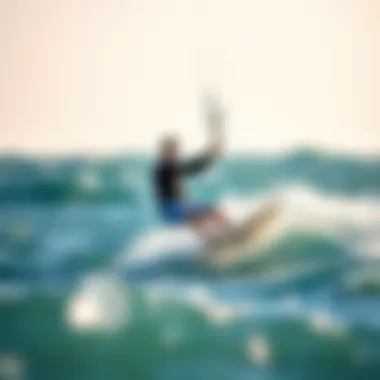
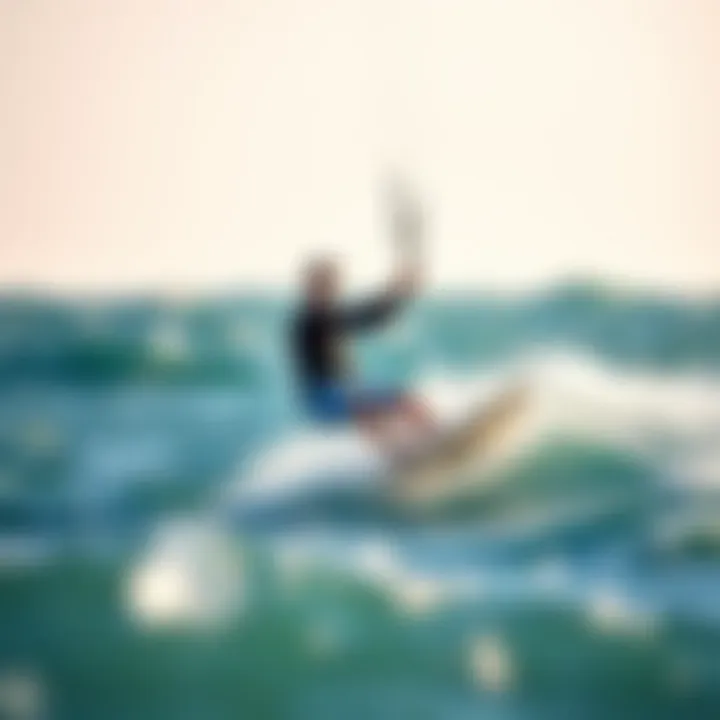
To really hit the waves with confidence, you need to prepare your body. Conditioning for kite surfing involves building core strength, improving cardiovascular fitness, and enhancing your flexibility. Here’s why these are crucial:
- Core Strength: Having a strong core supports your balance and stability on the board. Exercises like planks, Russian twists, and pilates can help build the muscles necessary for controlling your movements.
- Cardiovascular Fitness: Kite surfing can be a high-intensity sport. Good cardiovascular health allows you to maintain endurance throughout your sessions, especially when battling against the wind or tides. Activities like running, cycling, or swimming are helpful in boosting your stamina.
- Flexibility: Being flexible reduces the risk of injury and improves your range of motion, which is essential for various maneuvers. Try incorporating yoga or active stretching into your routine to maintain that flexibility.
Moreover, incorporating strength training at least twice a week can also contribute to your preparation. Resistance exercises that focus on your legs, arms, and back will serve you well when you're out on the water.
Mental Strategies for Performance
Equally important as the physical aspects is the mental game. Your mindset can significantly influence your performance. Here are some strategies kite surfers can utilize to enhance their mental fortitude:
- Visualization Techniques: Picture yourself successfully executing a maneuver before attempting it. Visualizing your movements creates a mental blueprint that can improve your motor skills.
- Focused Breathing: Managing stress and staying calm are crucial when things get tough on the water. Practicing deep breathing can help you maintain focus and remain in control of your emotional responses.
- Setting Realistic Goals: Rather than trying to master everything at once, set small, achievable goals for every session. This can help you track improvements and maintain motivation without feeling overwhelmed.
- Mindfulness Practices: Engaging in mindfulness can enhance your awareness while kite surfing. Being present helps in anticipating how to adjust your body to different conditions and responding accordingly.
The mental side of kite surfing is oftentimes what separates the good from the great. By managing your mindset, you can then navigate the challenges of the water more effectively.
Finally, don't forget that experience plays a huge part in building confidence. The more time you spend on the water, the better you’ll understand your limits and abilities. Remember, kite surfing requires both mental grit and physical readiness to fully enjoy what the sport has to offer.
Community and Culture of Kite Surfing
The world of kite surfing isn't just about the thrill of riding the waves; it’s also a rich tapestry woven from diverse experiences and interactions. The community and culture surrounding kite surfing play a crucial role in shaping the sport's identity. Unlike many water sports, kite surfing fosters a sense of camaraderie that often transcends geographical boundaries. It’s about sharing moments of joy, struggle, and achievement, a connection that pulls in kitesurfers from all walks of life.
Organizations and Associations
The backbone of kite surfing's community is formed by a multitude of organizations and associations dedicated to the sport. These groups serve several purposes, from facilitating resources to advocating for the development of safe and accessible kite surfing environments.
- International Kiteboarding Organization (IKO) - Committed to providing structure and training, IKO is perhaps the most recognized body in the global kiteboarding community. They offer standardized curriculums for instructors, which helps maintain a high-quality learning experience for newcomers.
- Kiteboarding Association Flukes - This organization operates at a much more regional or local level, empowering its members to host smaller events, workshops, and meet-ups. The connections made here often lead to lifelong friendships and local bonding over shared passions.
By joining these organizations, kite surfers not only stay informed about best practices and safety protocols but also get the chance to connect with like-minded individuals. These organizations help to foster local grassroots initiatives which can lead to site enhancements and community events, essentially feeding back into the growth and development of kite surfing culture.
Events and Competitions
Events and competitions represent the heartbeat of the kite surfing world. They bring together enthusiasts, seasoned veterans, and newcomers, creating an atmosphere of excitement and learning. Events range from local meets to large-scale competitions that attract global attention.
- Kite Surf World Cup - Drawing participants from around the globe, this event showcases elite athletes who compete for prestigious titles. The atmosphere at these competitions is electric, and they often become gatherings for those who share a fervent love for the sport.
- Local Competitions - Smaller competitions often take place at local beaches. These events serve dual purposes: they allow up-and-coming surfers to experience the thrill of competition, and they build a sense of community at the grassroots level. Competitors cheer for each other and share tips, creating a welcoming environment.
An important aspect of these events is the networking opportunities they present. While the competition can be fierce, it’s equally about forging bonds, learning from each other, and sharing stoke. Kite surfers often exchange techniques and ideas, promoting a culture of continuous improvement and innovation.
"In kite surfing, every wave conquered is a story, and every competition is a chapter that brings us closer together."
Embracing the community side of kite surfing opens doors not just to friendships but also to collaborative projects, mentorship, and even innovations in equipment and techniques. The culture that surrounds kite surfing is as exhilarating as the sport itself, with each participant contributing to an ever-evolving narrative that is deeply inspiring.
Future of Kite Surfing
The horizon of kite surfing is not just about catching winds and waves; it stretches far beyond. As the sport continues to evolve, several dimensions warrant a closer look. Understanding the future of kite surfing is crucial for enthusiasts, educators, and innovators alike, as it reveals opportunities for improvement, enjoyment, and sustainability. This ensures that not only do we enjoy the thrill of the ride, but we do so with an eye on responsible practices and advancements that can enhance user experience.
Technological Advances in Equipment
The leap in technology over the past few decades has propelled kite surfing equipment to new heights. Kites today, for instance, are more aerodynamic and responsive than ever before. Innovations include the use of lighter materials that enhance performance while also being easier to handle. Composite materials in kite boards allow for a balance between durability and sleekness, increasing glide and responsiveness to rider inputs.
Moreover, we are seeing advancements in smart technology integrated into kiteboarding equipment. Imagine a kite that has sensors to analyze wind conditions, or boards equipped with devices that track performance metrics—a simple smartphone app brings this information to the rider’s fingertips. This is not just about fancy gadgets; it’s about improving safety and providing valuable data that can help novice and experienced riders alike increase their skills and enjoy the sport more fully.
Additionally, the advent of inflatable kites has significantly improved stability and ease of use. Riders can now inflate their kites within minutes and head out, which lowers the barrier of entry for beginners. The focus now is also on fine-tuning the gear for different riding styles, making it easier for riders to find gear that suits their personal preferences, thus enhancing their overall experience.
- Enhanced materials: Lightweight and strong components for better durability.
- Data tracking: Apps and devices for performance analysis and safety.
- Customizable gear: Tailored equipment based on skill and riding style.
Environmental Impact and Sustainability
As kite surfing continues to gain popularity, the focus on its environmental impact grows equally significant. The sport inherently interacts with nature—oceans, lakes, and winds—so it is vital that the community takes steps toward responsible practices. Not only does this help preserve the environments we cherish, but it fosters a culture of respect among riders.
Sustainability initiatives in kite surfing gear production are already underway. Several brands are exploring biodegradable materials and processes that minimize carbon footprints. By shifting to eco-friendly materials, manufacturers aim to reduce waste both during production and at the end of a product’s life cycle, lessening the overall impact on our planet.
Moreover, kite surfing schools and communities are increasingly advocating for clean-up efforts at popular beaches and locations. This not only enhances the local environment but also sets an example of stewardship for newcomers. Understanding this impact doesn’t have to be daunting; it can be empowering, inspiring riders to engage in conservation practices while enjoying this exhilarating sport.
"By choosing eco-friendly gear and participating in community clean-ups, kite surfers contribute to the preservation of the beautiful environments they enjoy."
In summary, by observing the trends in technological advancements and adopting sustainable practices, the future of kite surfing not only holds promise for individual enjoyment but also for preserving the cultural and natural heritage vital to the sport. Without doubt, it's the combination of cutting-edge innovations and environmental consciousness that will define the way forward for kite surfing.






